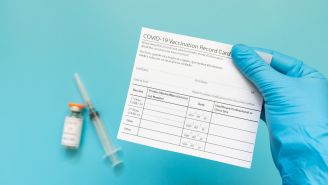Updated on May 28, 2020.
As COVID-19 lockdowns lift across the United States, millions of Americans are heading outdoors to soak up some nature. For many, it’s the first opportunity in months to hit the beach, go for a bike ride or take a walk in the woods.
And, unfortunately, it’s just in time for tick season.
“They're waking up after winter and they're hungry,” says John Aucott, MD, director of the Johns Hopkins Lyme Disease Research Center and associate professor of medicine at Johns Hopkins University School of Medicine in Baltimore. Like clockwork, he explains, ticks begin feeding in May, June and July “year after year after year.”
Blacklegged (deer) ticks, found primarily in the eastern U.S., often carry germs that cause Lyme disease, a bacterial infection believed to affect roughly 300,000 Americans annually. By taking the right safety measures, you can greatly reduce the risk of being infected. But some experts worry that Americans desperate to be outdoors may skip—or simply not be aware of—those important precautions
Perhaps more alarming, some of the early symptoms of Lyme are similar to those of COVID-19, which may make it difficult initially to tell the difference between the two. Ultimately, this could lead to confusion and delayed treatment, not to mention a lot of stress.
So, what is Lyme disease and how can you distinguish it from COVID-19? How should you alert your healthcare provider (HCP) about symptoms? And how can you protect yourself?
What you should know about Lyme disease
Ticks can be found in every state, but the vast majority of Lyme disease cases occur on the East Coast between Maine and Virginia, in Northern California and in the Upper Midwest. Tick season generally lasts from April through September, and the insects tend to congregate in tall grasses, short bushes and forests.
“They live in the leaf litter underneath the leaves where it's moist,” Dr. Aucott explains. “And if the weather gets too hot, they're not happy.”
Anyone can contract Lyme disease, but kids, older adults and people who spend a lot of time outdoors are at higher risk. It is only transmitted via tick bite. Mosquitos don’t spread the disease, and unlike COVID-19, you cannot catch it from another person.
Once you’re infected, Lyme disease can cause a wide variety of symptoms throughout your entire body. A large majority of people will develop its signature symptom: an oval or round red rash called erythema migrans.
“That red rash sometimes has a stereotypical bull’s-eye appearance, where it's like a Target department store ring within a ring, but not always,” says Aucott. “Sometimes it's just round and red, and people often mistake it for a spider bite.”
In its early stages, Lyme may also cause general symptoms like headaches, fatigue, fever, chills, or mild joint or muscle aches. Without treatment, in later stages you may develop musculoskeletal pain, heart issues, neurological problems and eye trouble.
Lyme disease vs. COVID-19
Early Lyme disease and COVID-19 have some of the same symptoms. “When you think about fever, chills, sweats, malaise, being achy all over—they're called flu-like symptoms,” says Aucott. “And they're common to lots of infections.”
At first, this may make it tough to tell the difference between the two. Fortunately, each illness has characteristic symptoms that distinguish it from the other. While they may not always be present, they’re excellent clues in the majority of cases.
One key feature that sets COVID-19 apart is respiratory trouble. “COVID patients will have the fever, chills and the flu-like symptoms,” Aucott explains, but they'll frequently have a cough, as well, and sometimes shortness of breath and/or a sore throat. By and large, Lyme disease does not present with symptoms involving your airways.
COVID-19 patients may also experience diarrhea or loss of smell or taste, neither of which are common in Lyme.
To identify Lyme disease, look for its characteristic rash. “Seventy percent of Lyme patients have the round, red rash,” Aucott says, “and that doesn't occur in COVID-19.”
Some people infected with COVID-19 do develop skin problems. Redness occasionally appears on the toes, or in rare cases of Multisystem Inflammatory Syndrome in Children (MIS-C), it’s a bumpy, red rash that could spread around the body. But these differ in appearance from a typical Lyme disease rash.
“Those are more generalized rashes, where the Lyme rash is really just a single skin lesion that occurs at the site of the tick bite,” explains Aucott.
Bottom line, what should you do if you begin to develop fever, chills or achiness? “The next step is you've got to ask more questions,” Aucott says. “Are there respiratory symptoms of COVID? Or is there a rash that would suggest Lyme disease?” Ask yourself, too, whether you may have been potentially exposed to either illness.
How to report symptoms
Whether you suspect you have Lyme disease or COVID-19, it’s important to reach out to an HCP right away, before your symptoms progress any further. Patients with the distinctive Lyme disease skin lesion can often be diagnosed via telehealth, especially if you live in a high-risk area.
“It's actually the perfect setup for telemedicine,” says Aucott. “If you can take a digital picture of the rash and transmit it to us as part of a telehealth visit, we can diagnose and treat based on that image because the image is so characteristic.”
If the rash is not present, your HCP can provide you with further instructions and determine if you need to be tested for one or both illnesses. If COVID-19 is suspected, you will be asked to isolate yourself from the other people in your home in the meantime.
How to protect yourself from Lyme
Just like washing your hands and practicing social distancing can help safeguard you from COVID-19, you can take precautions to avoid tick bites that could lead to Lyme disease.
“It's sort of like wearing a seatbelt when you drive a car,” says Aucott. “You’ve just got to do certain things to stay safe, to enjoy the outdoors.”
In the woods: If you’re hiking, camping or visiting high-risk areas, wear closed-toed shoes, long pants and a long-sleeve shirt. For extra protection, Aucott treats his clothes with permethrin, a safe chemical agent that kills ticks. You can also apply insect repellent with 10 to 35 percent DEET, up to 15 percent picaridin or another safe compound called IR3535. Kids should only have repellent with DEET applied one time per day.
When you’re in heavily wooded areas, avoid straying off paths. “The ticks are in the brush and the leaf litter. So, if you stay on a well-managed trail, you're less likely to get tick bites,” says Aucott.
Once you’re out of the woods, check your gear, clothes and skin for ticks. Concentrate on your armpits, ears, groin, the backs of your knees and your scalp. Dogs can carry ticks, too, so be sure to check Rover. When you arrive home, take a shower, wash your clothes in hot water and tumble dry them.
At home: While forest hikes get a lot of blame for Lyme disease, Aucott says that most transmission actually occurs around homes by wooded areas. “The majority of it is actually in your own lot, out in the woods on the edge of your lot,” he explains.
That’s a problem, because people tend to pass far more time on their own property than in the forest. So, to keep ticks away from your yard:
- Mow your lawn on a regular basis—shorter grass is safer—and if you’re comfortable with insecticide, treat the yard with a product containing bifenthrin or cyfluthrin.
- Landscape strategically, using woodchips, bark mulch or gravel to construct a boundary between wooded areas and your lawn. The Centers for Disease Control and Prevention recommends a 3-foot barrier.
- Place outdoor furniture such as tables and benches closer to the house in a sunny area.
“And you shouldn't put your kid's playsets out in the woods,” adds Aucott. “You put them on the manicured part of a lawn or on a bark area.”
If you find a tick: Grasp its body with thin tweezers and, without squeezing or twisting, pull it straight up using steady pressure. Then, clean the area with rubbing alcohol or using soap and water.
If the tick is already engorged, it means it’s been feeding on you for a long time. Call your HCP for directions on what to do next. When it’s caught early, Lyme disease is typically treatable with antibiotics, and most people recover completely.
The bottom line
Getting outside is a good thing, perhaps now more than ever. But as you embrace the great outdoors, remember to take the necessary precautions against Lyme disease. Not only can it prevent some big headaches, it can free up healthcare for those who may be in serious need. During the pandemic, a little prevention goes a long way.






